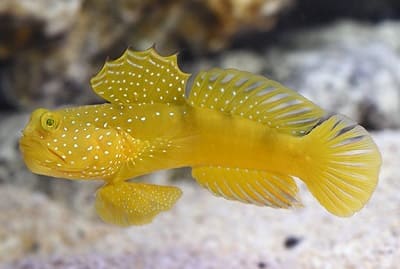Home › Sea Life › Marine › Vertebrates › Gobies › Yellow Prawn-Goby
Facts about Yellow Watchman Gobies
[Phylum: Chordata] [Class: Actinopterygii] [Order: Gobiiformes] [Family: Gobiidae]
The bright body colouring, and a non aggressive nature, are two reasons why some aquarists will keep the yellow prawn-goby fish as a pet.
This section contains interesting facts and information about the yellow watchman goby, such as where they live, what they eat, and how they reproduce.
Yellow Prawn-Goby Habitat and Distribution
The scientific name for this "easily recognisable" species of goby fish is Cryptocentrus cinctus.
These gobies fishes are native to the Western Pacific and many eastern areas of the Indian Ocean.
Hence, scuba divers will find them in most of the Asia dive sites, all the way through New Caledonia, and around the Great Barrier Reef.
Yellow watchman gobies prefer to live in shallow water environments - at depths of only one or two metres.
Even so, they can also exist quite well even in deeper water, including depths of twenty five metres (82 feet). This bottom-dwelling species develops burrows to live in, especially on the sandy slopes and seabeds of protected coastal bays and lagoons.
Behaviour and Characteristics
Like most Gobiidae fish families, the bright yellow colouring and large frog-like eyes are notable features of prawn-gobies. Even so, it's not uncommon to find grey or brown coloured Cryptocentrus cinctus.
They all display a broad, drooping mouth and some will have tiny blue flecks dotted around the belly. Adult yellow watchman goby fish will grow to a maximum of ten centimetres (4 inches).
Pro Tip: The intriguing symbiotic relationship between the prawn-goby and the alpheid shrimp is one reason why aquarists introduce them as part of their fish keeping hobby (e.g. in saltwater aquariums).
What Do Goby Fish Eat?
Their favourite food is algae, planktonic organisms, and other types of small invertebrates. Yet, some of the large species feed on other small fishes. Whereas, the smallest of the genera will stick to planktonic algae for their food source.
 Goby Fish Reproduction
Goby Fish Reproduction
Male and females typically share the burrow which provides them with a sheltered place to spawn.
The genders dig with their mouths and keep the burrow clear of debris by fanning away sedimentary sand.
Gobies will place small fragments of shells, rubble, and corals to block the entrance of their hole, especially during spawning season.
The eggs stick to vegetation such as coral and substrate. The male supervises the eggs for a few days until they hatch.
Most of the young will only take a few months to reach adult maturity. In general, warm water dwellers can live for a period of up to ten (10) years.
Threats and Predators
A recent assessment carried out by the IUCN Red List of Threatened Species spotlights the yellow watchman goby (Cryptocentrus cinctus) as being of Least Concern (LC).
For the most part, there are no major threats to the species and they will also breed when kept in captivity. Thus, they are collected and used commercially in the aquarium trade.
Related Information and Help Guides
- Blenny Fish Facts and Species Information
- Dwarf Pygmy Goby Facts and Information with Pictures
- Facts about Fire Goby (Nemateleotris magnifica)
- Marine Vertebrates with Examples and Pictures
- Wrasse Fish Species Interesting Information
Note: The short video [4:13 seconds] presented by 'Eagle Aquatics' explains more about the partnership between the yellow watchman goby and the blind pistol shrimp.